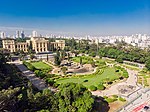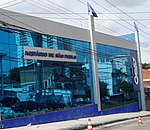Museum of Zoology of the University of São Paulo
The Museum of Zoology of the University of São Paulo (Portuguese: Museu de Zoologia da Universidade de São Paulo, abbreviated MZUSP) is a public natural history museum located in the historic Ipiranga district of São Paulo, Brazil. The MZUSP is an educational and research institution that is part of the University of São Paulo. The museum began at the end of the 19th century as part of the Museu Paulista; in 1941, it moved into a dedicated building. In 1969 the museum became a part of the University of São Paulo, receiving its current name. The MZUSP has one of the largest natural-history collections in Latin America, with over 8.5 million preserved specimens of vertebrates (amphibians, mammals, birds, fish and reptiles) and invertebrates (cnidarians, insects, crustaceans, arachnids, myriapods, annelids, mollusks and other marine groups). Each collection is curated independently, and organized according to specific needs. Other facilities in the museum include a library specializing in zoology and laboratories dedicated to research in chronobiology, electron microscopy, molecular biology, histology and CT scans. MZUSP also operates the Boracéia Biological Station in the forest near Salesópolis for field research.
Excerpt from the Wikipedia article Museum of Zoology of the University of São Paulo (License: CC BY-SA 3.0, Authors).Museum of Zoology of the University of São Paulo
Avenida Nazaré, São Paulo Ipiranga (Ipiranga)
Geographical coordinates (GPS) Address Phone number Website External links Nearby Places Show on map
Geographical coordinates (GPS)
| Latitude | Longitude |
|---|---|
| N -23.5882 ° | E -46.6101 ° |
Address
Museu de Zoologia da USP
Avenida Nazaré 481
04263-000 São Paulo, Ipiranga (Ipiranga)
São Paulo, Brazil
Open on Google Maps










